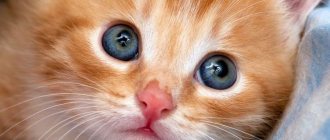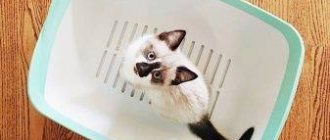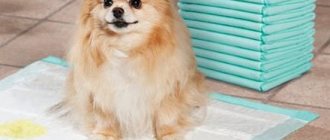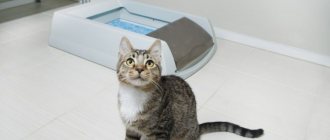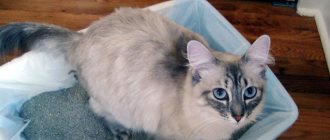General information about the kitten's toilet
How long should a kitten poop?
It is important to know the rate of bowel movements in order to protect your furry baby from health problems. One month old kittens can poop on their own 3-6 times a day. When changing place of residence, the pet may not poop for about 5 days. After an adaptation period, the stool usually returns to normal, otherwise it is worth taking action.
You can give your pet a light massage of the abdomen and groin area
For your information! The toilet of a newborn kitten is under the complete control of the mother cat. The first three weeks after birth, the cat licks the baby. At the same time, not only body hygiene is observed, but also stimulation of blood circulation and the functioning of the digestive organs.
While licking, the cat uses its rough tongue to massage the belly and groin area. Thus, the sphincter of the anus and the urinary canal are irritated and relaxed, resulting in urination and defecation. The cat licks all the discharge, so the owners cannot detect traces of the kittens’ bowel movements for the first time after their birth.
Sometimes inexperienced females do not properly care for their babies. Your kitten may suffer from a bloated belly where feces and gases have accumulated. The owner can come to the aid of the baby. It is enough to take a brush, bandage or a little cotton wool and gently massage the groin area. This will help the kitten go to the toilet and get rid of discomfort.
To improve digestion and remove gases, you should massage your stomach using circular movements.
How should a kitten go to the toilet?
Cats also have problems with stool.
Especially in small kittens. How should a kitten go to the toilet, how many times and what kind of feces should it be if it does not have digestive problems. All this in today's article on this delicate topic. What gives cats energy throughout the day? Of course, this means healthy sleep and proper nutrition. As you know, the main function of food processing is performed by the stomach.
After our pets have eaten, the digestion process begins in their stomach, during which complex substances are converted into simple ones. And this is necessary so that the cat’s body can receive everything it needs.
During digestion, harmful or simply undigested substances remain, which, in turn, are eliminated through bowel movements.
If a kitten has digestive problems, the entire body of the growing pet will suffer.
In this article we will talk about how our pets go to relieve themselves, that is, how they poop, pee, and what needs to be done if they do not do it well. And also about how in the first weeks of birth our pet goes to relieve itself and what needs to be done if it has difficulties.
How should a newborn kitten go to the toilet?
A newborn kitten is helped to follow the call of nature by its mother cat. It all happens as follows: when the mother licks the baby, she massages his tummy with her tongue, and these actions help him relax.
After this procedure, the kitten’s sphincter begins to relax, and defecation occurs, and the mother, in turn, cleans up after the baby, licking off everything that the baby has excreted.
This is why in most cases it is difficult for cat lovers to find feces of newborn kittens.
However, there are times when a cat has not taken care of her kitten, and then its tummy begins to swell from accumulated feces and gases, which leads to discomfort and pain in the stomach.
If suddenly this happens to your kitten, then you need to first massage its tummy, making clockwise circular movements, and then, using a brush or cotton wool (a bandage will do), begin to artificially soften the tissues of the groin area.
How do three week old kittens relieve themselves?
In the first three weeks after birth, the kittens’ stomach begins to actively develop, the body becomes ready to accept new food, and if the kitten is properly cared for and fed, it will begin to “go to the toilet” on its own. It is best to feed your baby exclusively liquid and semi-liquid foods during this period.
Ideally, he will be fed by his mother with her milk. Well, if you only have a kitten, then give him exclusively liquid food, pre-beaten in a blender: this will help him when going to the toilet and in the general formation of stool. At this age, a kitten should poop 3-6 times a day, which is considered normal.
All cat owners know that our fluffies are very shy and therefore relieve themselves in all the secluded places of the house, which complicates the counting process. If your kitten is active and energetic, and his tummy is soft to the touch, this means that the baby is in excellent condition and you do not need to worry about him.
And if the feces have become too thick or he is diarrhea, then this means that his stomach is not functioning properly.
When your kitten cannot relieve itself for a long time (3-4 days), start massaging its tummy and give it a teaspoon of oil. The most important thing during this period is proper nutrition.
Cotello in Trusells
How should an older kitten go to the toilet?
From the time the kitten turns one month old, it must be gradually transferred to the food of adult cats, and the transition process should last two months, no less. With a change in food, the appearance of stool also changes. The feces become thicker and harder and no longer resemble a homogeneous mass.
The number of times a kitten goes to the toilet will depend solely on its nutrition. If plant foods predominate in the food, the baby will walk “big” more often than if he ate mainly protein foods.
At this age, you need to pay attention not to the quantity, but to the quality of daily feces. The most important thing is that the feces are thick and free of blood.
If a kitten often walks around and diarrhea, then this means obvious destabilization of the intestines.
As for how often your kitten should urinate, this will depend solely on how much liquid he has drunk.
, please select a piece of text and press Ctrl+Enter.
What determines the number of acts of urination per day?
The frequency of urination in cats depends on many factors. The main ones:
- Floor. Cats go to the toilet less often than males. This is due to the anatomical features of the structure of the genitourinary system: the urinary canals in cats are narrow and hold less urine. Because of this, the outflow of urine occurs more slowly, and the cat has to go to the toilet more often.
- Age. In kittens and older cats, this indicator may differ up or down, which is associated with age-related changes in the functioning of the urinary system.
- Activity. Energetic pets consume a lot of water, and the number of trips to the litter box also increases. Passive cats drink less and urinate less often.
- Nutrition. Depending on whether your cat eats natural food, wet food or dry food, she may drink more or less liquid, which affects the number of times she visits the litter box.
- Sexual activity. Due to hormonal changes during heat, both males and females tend to urinate more frequently. Some of them tend to mark their territory with urine.
- Pregnancy. In cats expecting offspring, the frequency of visits to the litter box may increase due to the fact that the enlarged uterus puts pressure on the bladder.
- External conditions. Pets often pee in the summer - this is caused by increased thirst in the heat. The same effect is observed during hypothermia.
- Taking medications. The frequency of visits to the tray may change during treatment with diuretics, glucocorticosteroids, and anticonvulsants.
How often does a kitten defecate?
Normal bowel movements in a kitten depend on a number of factors. The most important is age. Gender and health indicators are equally important.
How often should a kitten poop: normal bowel movements by age
The cat often goes to the toilet a little at a time
How many times a day should a kitten go to the toilet? Normal bowel movements depend on many factors. One of the main ones is age. The gender of the kitten and its health status are also important.
- at the age of 1-21 weeks, the norm of bowel movements is 3-4 times;
- at the age of 3 to 6 months - 2-3 times;
- over the age of 6 months - 1-2 times a day.
Three-week-old kittens should normally be fed their mother's milk with the gradual addition of solid food. Their feces have a thick and mushy consistency without foreign impurities. There should also be no undigested pieces of food in the stool. A deviation from the norm is considered to be too loose or too dry stool.
The older the kitten, the less often he defecates.
Adult kittens up to three months old are transferred to adult food. As a result, the nature of their bowel movements changes. The feces take on clearer shapes and become thicker. The frequency of visiting the tray depends on the nature of the food. When eating plant fiber, bowel movements occur more often, unlike animals, whose food mainly consists of protein.
Important! The feces of a three-month-old kitten should be of medium thickness without foreign impurities. Too frequent bowel movements or loose stools indicate some kind of disorder in the body.
Females and males go to the toilet differently. Cats pee more often. This is due to the physiological characteristics of the urinary tract. In males they are narrower and longer than in females. If your cat's diet is rich in fiber, he may go to the toilet more often.
How often should kittens pee?
What to feed a kitten for 2 months: how many times a day and what food
Veterinarians give owners of small kittens a simple rule that helps determine normal urination in their pets. The essence of the rule is that the amount of fluid entering the body must be equal to the fluid excreted in the urine. The baby has a small bladder, so he will go to the toilet in a small way more often than an adult cat.
The rate of urination also depends on the age, gender and health status of the children:
- at the age of 1-21 weeks, a kitten can pee about 3 times a day;
- animals 3-6 months old defecate 6-10 times;
- Pets older than 6 months pee on average up to 5 times.
With the introduction of complementary foods, kittens can be litter trained
When visiting the toilet, the owner must monitor the quality of urine. You need to pay attention to color, transparency, the presence of blood or mucus impurities. It is also worth noting the process of urination. Normally, it should be comfortable and painless for the baby.
Table: number of bowel movements during the day
| Age | Urination | Defecation |
| From 1 to 21 weeks | until 3 | from 3 to 4 |
| From 3 to 6 months | from 6 to 10 | from 2 to 3 |
| From 6 months and older | up to 5 | from 1 to 2 |
There is a difference between males and females. Cats often go to the litter box in small sizes. This is due to the physiological structure of the urinary tract; they are narrower and longer than those of females.
The number of trips to the toilet may increase significantly if the kitten eats food with a high fiber content.
When does a kitten start going to the toilet on its own?
In the first three weeks after birth, the cat takes care of the kitten's toilet. From the outside it may seem that newborn kittens do not defecate at all. The mother monitors the hygiene of her cubs and licks off any secretions, cleaning out impurities. The cat massages with its tongue, stimulating the digestion process of newborn kittens. This helps them pass stool. In addition, gas formation in the small belly is reduced.
In the first weeks of life, the baby's toilet is monitored by the mother cat.
If kittens are left without a mother for some reason, they cannot go to the toilet on their own, which is why they can die. When kids find themselves in such a situation, they definitely need help. A regular cotton swab dipped in warm water is suitable for this. They are given a light abdominal massage. It is important not to press, but simply move the tampon in different directions.
Accustoming a kitten to adult food and litter tray
Starting from the 22nd week of a kitten’s life, it can be gradually introduced to complementary foods. To do this, you can use special canned food for kittens. If food is prepared independently, then the baby should be given it chopped. Gradually, the amount of mother's milk in the kitten's diet decreases, and it completely switches to adult food. At this time, his feces change their structure and shape. They become more formed and dense. At the same time, it is advisable to start accustoming your baby to the tray. The toilet should be placed next to the box where he lives and sleeps. The sides of the tray should be low so that the baby can climb into it himself. It is better to choose crumbly filler. This will help the kitten develop a digging reflex and get used to the toilet.
The frequency of replacing the litter in the tray depends on how often the kittens poop and pee.
The ideal option would be to help a mother cat. Kittens willingly follow the example of adults. If a cat goes to the litter box when the baby is present, the kitten will quickly learn to do this on its own. Over time, the tray can be moved to another more suitable location.
How to help your pet if he has problems with stool?
Upon reaching the age of one month, the digestive organs of a cat cub are fully formed and filled with beneficial bacteria.
The basis of nutrition is mother's milk, but it must be gradually supplemented with other products that facilitate the baby's transition to independent feeding.
The main food elements included in the list of possible complementary foods:
- thin porridge;
- pate from boiled meat, fish;
- lactic acid products.
Pet owners need to familiarize themselves with the main rules for introducing complementary foods for kittens:
- The transition should begin by giving warm milk. If the kitten does not understand how to lap, it is recommended to gently poke the pet’s muzzle into the drink. By licking himself, he will understand how to act.
- Then you can offer your pet thin porridge or meat pate.
There are also industrial feeds for feeding kittens. They can be started from 1 month.
At first, you will have to wipe the kitten after each meal. Gradually, he will learn to do everything carefully and independently clean his face of food debris.
Be sure to read:
How often do kittens poop and pee, how many times a day, how to understand that he wants to go to the toilet
If the kitten is close to its mother, the cat herself teaches him all aspects of life, including going to the litter box. In cases where the baby moves to a new home, from the first day the owners should develop the pet’s habit of defecating in a place specially designed for this purpose.
Initially, the tray should be in the same room as the animal. After getting used to it, the cat potty is moved to the right place.
Pathological deviations from the norm
How often can you wash a cat - how many times a month and examples of when not
The animal may experience abnormalities in normal urination. Veterinarians distinguish between safe and pathological cases. Safe ones include:
- stress caused by moving or the appearance of a new pet or stranger in the house;
- acclimatization;
- change of feed;
- procedure of castration, sterilization or other surgical operations.
All these factors are temporary. After an adaptation period, the number of urinations returns to normal.
You should take full responsibility for kittens who have begun to go to the toilet less often for more serious reasons. Such children usually exhibit abnormalities resulting from the development of various pathologies. If the cat cannot pee for more than two days, or the process itself causes her pain, or the amount of urine is very small, then it’s time to seek help.
The main cause may be an inflammatory process in the genitourinary organs. Signs of pathology are:
- plaintive meowing when urinating or inability to go to the toilet;
- presence of traces of blood, sand or mucus in the urine;
- lack of urination;
- scanty discharge;
- lack of appetite, apathy;
- increased body temperature;
- swollen belly;
- dry and hot nose and ears.
Deviations from the norm can be caused by pathologies in the body
If there is difficulty urinating, the kitten may take a characteristic position while in the tray. It is worth remembering that an animal may not go to the toilet if it is dirty or if it does not like the litter in the tray. Pathological deviations from the norm require immediate contact with a veterinarian. If you let the situation take its course, the kitten may die.
Toilet training a kitten
Many owners teach their pets to use the toilet from an early age, and the learning process is quite simple and usually takes from 2 to 4 weeks.
Below are detailed instructions:
- Initially, it is necessary to accustom the kitten to the tray using the method described above.
- The tray is moved closer to the toilet every day until they are close to each other.
- Newspapers are placed under the tray; daily the height should increase by about 1-2 cm. If for some reason this begins to scare the pet away from the toilet, then the raising process should be stopped for several days.
- It is necessary to constantly check the structure for its stability , since even a single fall can undo all the progress achieved.
- After 10-12 days, the tray should already be on the same level as the toilet seat , after which no action should be taken for 3-4 days to allow the pet to adapt to the new conditions.
- Over the course of 2-3 days, the tray is gradually moved towards the toilet seat until it is completely on it.
- After the specified period, the tray and newspapers are completely removed, and a plastic container is placed across the toilet bowl, which will contain litter with the kitten’s usual smell. The toilet lid should always be open so that the pet, sensing a familiar smell, goes to the toilet while sitting on the edge of the toilet.
- Usually, another 3-4 days are enough for complete adaptation, after which you can completely remove all containers with filler. It is enough just to promptly flush after the cat and wipe the toilet rim after it.
Signs that a kitten wants to go to the toilet
Many owners have kittens growing up without a mother cat. In such cases, training and litter box training are the responsibility of the owner. First of all, a person should know when the kitten wants to go to the toilet. At this moment, the animal gives specific signs. It's important to just keep an eye on it. The baby wants to go to the toilet if:
- scratches on the floor and other objects;
- sniffs everything around, looking for a place to defecate;
- stomps around in one place, meows subtly and sits down;
- With a strong desire to go to the toilet, the kitten's eyes become glassy. The owner should know that the baby urgently needs to be placed in the tray.
Tray training should be leisurely. It is important to change the litter on time, as the kitten may refuse to go to a stale toilet. Do not neglect to pay attention to the feces and urine of the animal, to see if there are any foreign impurities, pus, worms, blood or mucus. Timely identification of the problem and contacting a veterinarian will prevent the occurrence of serious diseases and complications, which in the future can lead to intractable health problems and even the death of a small pet.
Everything you need to toilet train your kitten
Before you begin training your kitten, you will need to make sure that you have everything necessary for this process:
It is recommended to make a choice in favor of odorless fillers, and you can experiment by purchasing a clumping and non-clumping variety
- Tray. There are many different varieties of cat litter available at pet stores, but for kittens in the learning phase, an open litter box with low sides . A tray with high walls or a door will be too difficult for a kitten to climb into, which can significantly slow down the process of habituation. Starting from 5-6 months of age, you can take a closer look at closed models of cat litter.
- Filler or lack thereof.
- If you bought a kitten, then ask the breeder which option the baby is accustomed to. Good nurseries sell babies who are already toilet trained, but in a new place you need to reinforce the habit.
- Outdoor foundlings are used to relieving themselves in sand and soil, so take a closer look at clay or wood pellets.
- If the tray is used without filler , then be prepared to clean the toilet immediately after the pet so that the smell does not spread throughout the room. It may be worth installing a couple of litter boxes to ensure your kitten always has access to a clean litter box.
- Selecting filler type . If you have several cats, it is better to take an absorbent litter, while a clumping one will make daily cleaning of the litter box easier.
- A set of sprays that have scents that are attractive and repulsive to cats. They may be required if the kitten ignores its litter box or systematically goes to the toilet in a chosen place that is not intended for such purposes.
- Scoop for cleaning the tray.
- Bedding , which is usually placed under the tray. It may be required so that the kitten, when getting out of its litter box, does not spread litter particles around the house on its paws. Pet stores usually sell special rubber mats that are very easy to clean.
- partition may be required if you need to create a temporary enclosed space for your kitten in close proximity to the litter box to get used to it.
- The food bowl and tray should be located sufficiently far from each other. At the same time, during training, it is recommended to limit the kitten’s movement around the apartment: it is advisable that he always stay in the same room until he understands what exactly is required of him.
How many times a day should a kitten and an adult cat normally pee?
The normal number of urinations per day depends on the age of the animal. Newborn babies urinate only once a day. After 2–3 months, the kitten usually pees 2–3 times, and at 6 months, the daily frequency of trips to the toilet increases to 6. If the indicator slightly deviates from these values, there is no need to sound the alarm, provided that the baby feels well, since the urinary system is kittens continue to form.
How much should adult animals pee? Cats should walk small 1-2 times a day, males - 2-4 times. Castrated males urinate frequently - 5-6 acts of urination per day are considered normal. Older cats usually pee more often than younger ones, which is due to a weakening of the bladder sphincter.
What to do if the kitten cannot poop and does not go to the toilet
If 2-3 month old babies, as well as older kittens, do not have a bowel movement for more than three days, first of all do a light massage of the peritoneum. Use gentle circular motions to massage your pet's abdomen.
If the kitten is constipated and cannot poop for more than five days:
- Make a microenema. The enema procedure should be carried out only if there are no contraindications, constipation is caused by an unbalanced diet.
- Insert a small piece of baby soap into the baby's anus, after moistening it in warm water. This procedure is best done when the cat is sleeping.
- You can give your pet enzyme preparations and probiotics, after consulting with your veterinarian. If your baby is constipated, mild laxatives prescribed by your veterinarian will help.
- Dilute condensed milk 1:1 with warm boiled water. Give your pet small portions of the mixture three to five times a day. You can pour the mixture into the animal’s mouth using a regular syringe without a needle.
To normalize the act of defecation, you can also add a few drops of vegetable oil to the food. In order for the kitten to go to the toilet in a big way, it is best to use Vaseline, since it is not absorbed into the gastrointestinal tract and does not burden the liver. In this case, the main emphasis should be on correcting the furry pet’s diet. You can purchase food marked “For kittens.”
Possible problems with urination and defecation in kittens
A small kitten must be properly cared for so that it can develop and grow normally. If he is separated from his mother and finds himself in the house of a new owner, then the adaptation period may be accompanied by stress. A number of negative factors can affect the weakening of an animal’s immunity. This affects the functioning of all body systems. Absence or problems with urination and bowel movements during this period are quite acceptable.
When the kitten has grown up and settled down, has become the owner of an excellent appetite, but does not go to the toilet properly, it is worth wondering if everything is okay with him.
How to deal with constipation in a kitten yourself
If your pet feels well enough, you can try to cope with your kitten’s constipation yourself with the help of:
- Oils: if the kitten does not go to the toilet for several days, you can give simple vegetable oil in an amount of no more than half a teaspoon per day. You can introduce it into the mouth using an ordinary syringe without a needle, slowly so that the kitten does not choke. Vaseline oil is also effective for constipation. It can be added at each feeding, 0.5 ml, in combination with a gentle therapeutic massage.
- Soap: you need to make a small peg of baby soap and insert it into the anus. Before administration, the soap should be moistened in warm water. It is more convenient to carry out this action while the pet is sleeping. After it, within a few hours, the kitten should successfully go to the toilet for the most part.
- Medications: You should consult your veterinarian about the appropriateness and correct use of medications.
- Enema: the enema procedure at home is carried out only in full confidence that it is harmless to the kitten. This procedure is relatively safe only if the cause of constipation is precisely inappropriate nutrition, and not intestinal obstruction or volvulus. There is a list of conditions for which an enema is strictly contraindicated: inflammatory processes in the intestines, bleeding, rectal prolapse, acute pathologies of the abdominal organs, inflammatory processes in the intestines.
Do-it-yourself enema of a kitten
To do an enema yourself, you will need a 10-milligram syringe, warm boiled water, Vaseline or oil. It is advisable to do the procedure with an assistant: one will hold the kitten, and the second will slowly insert a syringe pre-lubricated (with Vaseline or oil), deep enough so that the liquid is distributed as intended.
During the procedure, you need to slowly introduce water, gently palpating the pet's stomach to ensure that the intestines are sufficiently full. For a kitten, 50-100 ml of water is enough for the procedure.
Frequent stool
When a kitten suffers from diarrhea, this is a sign of a serious malnutrition problem. This situation will require urgent measures and treatment. The entire course of therapy must be carried out under the supervision of a veterinarian.
The most common reason is a change in diet. If the kitten does not receive its usual food, diarrhea occurs. It is necessary to return to your previous diet as quickly as possible.
Changing a kitten’s diet should not be abrupt; it is carried out according to a certain scheme.
There are other reasons for frequent bowel movements in kittens:
- Binge eating. Food that comes in large volumes cannot be digested normally and enters the intestines in liquid form. It is important to control kittens' portions according to their age.
- The food is not suitable or bad. You cannot feed your kitten pickled, fried, salted, or expired foods. This food is not suitable not only for kittens, but also for adult cats. It is not absorbed and causes diarrhea. Also, cats are not given food from the owner’s table (primarily because it contains salt, sugar or spices); food for animals must be prepared separately.
- Allergies or intolerances. Often kittens cannot digest or assimilate fatty fish, beef, and corn. It happens that some elements cause an allergic reaction.
- Poisoning. This phenomenon can be caused not only by food, but also by various substances. A kitten, due to its curiosity, can fit anywhere. Therefore, household chemicals and other chemical elements should be stored out of reach. If the baby is poisoned, then vomiting and lethargy will be added to the diarrhea. Only a specialist can help here.
- Parasites. The first and obvious sign of a kitten being infected with worms is diarrhea with mucus. Only medications can help here. If the case is advanced, then the help of a veterinarian is needed.
- Diseases. The cause of diarrhea can be infectious lesions in the body of a small pet.
Determining the causes of diarrhea
To get rid of the problem of frequent bowel movements, you need to find out its cause. To do this, you need to conduct a stool analysis. Factors of color, consistency, and impurities play a role here:
- Stool with a yellow tint will indicate that the kitten has been poisoned by some kind of food.
- If the feces have an admixture of blood or mucus, then this speaks in favor of helminthic infestation.
- Brown diarrhea indicates an allergic reaction.
- If the stool has a green tint and a persistent unpleasant odor, then the kitten has been poisoned by chemicals.
How to help a kitten with diarrhea
If loose stools have become a one-time occurrence, and the kitten feels normal, that is, he is alert and does not have a fever, then you can simply give the baby plenty of water and put him on a diet. The food restriction should continue for several days until everything returns to normal. In addition, you can give your pet a quarter of a tablet of activated carbon. If diarrhea is prolonged, accompanied by a deterioration in general condition, then an urgent visit to a doctor is necessary. He will be able to diagnose the cause and prescribe treatment.
Urination in kittens: normal and abnormalities
In order to determine how often a kitten pees, you need to track how often it drinks water. The amount of fluid you drink should correspond to the amount of urine. An older kitten will empty its bladder up to 5 times a day. The process does not cause discomfort to the baby. Urine should be clean and transparent without any admixtures of blood or mucus.
Acute urinary retention
Acute urinary retention is a condition in which the animal does not urinate for 24 hours. It is dangerous and life-threatening for the pet. As a result of excessive overfilling, the bladder may rupture, causing urine to leak into the abdominal cavity. Intoxication of the body occurs, and then the death of the pet occurs.
Acute urinary retention is more often detected in cats, but in cats it is classified as an infrequent pathology.
The cause of this dangerous pathology is most often stones that block the outflow of urine. However, there are a number of other factors that experts highlight:
- Obstruction (blocking) of the urethra with a blood clot or mucus, pus. Often occurs in cats that have had a trauma to the penis or a disease associated with an infectious carrier that has affected the specified organ. This can also be caused by a bladder infection.
- Kidney dysfunction. The animal's body becomes unable to excrete even a minimal amount of urine. This may be due to organ perforation or tumor.
- Spinal injury or infection that has penetrated the spinal cord. In this case, the innervation of the urinary and urinary organs may be disrupted, which is why the animal stops urinating.
Acute urinary retention requires immediate medical attention. There they can do:
- Catheterization. A special catheter is inserted into the urethra, through which the bladder is emptied.
A catheter is inserted into the urethra, allowing urine to flow out
- Operation. It is performed after several catheterizations if the cause of urinary retention cannot be eliminated by conservative methods.
My cat has had her bladder catheterized several times. But the problem could not be solved in this way. The outflow of urine was hampered by the appearance of a tumor. We agreed to the operation, but, unfortunately, the cat did not survive it; she was already an elderly lady.
No urination
If a kitten pees little or does not pee at all, there may be a number of reasons for this:
- suffered stress;
- diseases of the urinary tract;
- kidney disease;
- small amount of fluid consumed;
- exhaustion.
Also, the kitten may not visit the litter box if it is dirty, he does not like the litter, etc.
Many cats are very picky about the cleanliness of the litter box and the contents in it.
If the baby does not pee for a long time, and the owner notices weakness and apathy, lack of appetite, irritability, then you should urgently contact a veterinarian to establish a diagnosis and begin timely treatment.
No matter how many cats and kittens appeared in my house, during the first 24 hours no one peed or pooped. When entering a new home, any animal experiences stress. We understand that he will feel good here, no one will offend him. The cat is not sure about this yet. Therefore, she has no time to relieve herself. She should investigate everything and calm down.
Frequent urination
If a kitten pees frequently, then most likely he has developed cystitis, a disease of the urinary organs, or urolithiasis. The baby will often run up to the tray, but the volume of urine will be catastrophically small. Sometimes there is blood in the urine.
Frequent urges can be caused by drinking too much in hot weather, as well as diabetes. Urinary incontinence is accompanied by a large amount of fluid released and no bleeding. The same signs are characteristic of marking territory.
Cystitis most often occurs in adult kittens. The reasons may be:
- drafts;
- sand in the kidneys;
- impaired metabolism;
- mineral imbalance;
- sexual infections;
- predominance of dry food, lack of liquid and proteins.
Deviations from the norm should be studied and treated in veterinary clinics
Cats of any age can get urolithiasis. Signs of the disease are:
- unsuccessful visit to the tray;
- a tiny amount of urine;
- presence of blood in the urine;
- vomiting and high fever;
- lethargy and apathy.
There are cat breeds that are genetically predisposed to this disease. Among them are Scottish Fold, Persian and Siamese breeds.
Also, frequent urination can be associated with diabetes, stress or enuresis. In any case, assistance to the pet must be qualified and timely. If there is the slightest sign of a pathological condition, you should immediately contact a veterinarian. He will prescribe a number of diagnostic measures and adequate treatment.
A kitten who pees frequently will undergo the following tests:
- blood biochemistry;
- Analysis of urine;
- X-ray;
- comparison of the amount of urine and drink;
- Ultrasound;
- hormone test;
- determination of acetone levels and acid-base balance.
These types of studies will help to identify the nature of the disease of the genitourinary system, make a diagnosis and decide on treatment.
In addition to adequate therapy, it is important to carry out a number of preventive measures for the full functioning of the genitourinary system. Regular medical examinations, proper diet, physical activity, and the optimal amount of drinking will ensure normal urination and healthy urinary tract of the kitten.
Too infrequent visits to the litter box
Rare urination is just as dangerous to a kitten's health as frequent urination. In such situations, the main cause is pathological processes, both in the genitourinary system and in the body as a whole. Almost 75% of cases of insufficient urine flow or insufficient discharge occur due to cystitis. Lack of proper treatment will invariably lead to a condition such as acute urinary retention.
Having such a diagnosis, a kitten may not walk for more than a day. This is a dangerous phenomenon that often ends in death. The bladder becomes full and bursts. Urine enters the abdominal cavity, which can lead to intoxication of the body and death of the pet.
Kittens need to be fed crushed food.
The pathology most often occurs in male kittens. For females, such a disease is not typical, although it is also sometimes detected. The main cause of the disease is stones that block the urinary tract. Experts identify other factors:
- blockage of the urethra by a blood or mucus clot. Occurs against the background of trauma to the genital organ or an infectious disease, in particular the bladder;
- abnormal kidney function. With renal dysfunction, the kitten’s body can no longer excrete urine even in minimal volumes. The cause may be a malignant tumor or perforation of the kidney;
- spinal injury or infectious disease affecting the spinal cord. The absence of a nervous connection between the genitourinary organs and the spinal cord leads to disruption of their functioning and the cessation of urination of the animal.
Urinary retention of any stage requires urgent treatment. In the clinic, a kitten may be prescribed the following procedures:
- catheterization using a special catheter that is inserted into the urethra. This will help empty your bladder;
- surgical intervention. Prescribed in case of ineffectiveness of repeated catheterization.
To prevent advanced cases of impaired urination, the owner of kittens must take preventive measures daily:
- animals must receive anti-infective vaccinations on a schedule;
- avoid hypothermia;
- provide access to an unlimited amount of fresh and clean water;
- the diet must comply with the kitten’s nutritional rules according to its age;
- an active lifestyle and outdoor games will also be beneficial.
For any pathological conditions or deviations from the norm, it is prohibited to prescribe medications yourself. Kittens must be treated by a veterinarian. He will also tell you how many times a kitten should poop and pee per day. This will keep your little pet healthy and alive.
Symptoms and prevention of urolithiasis
Having decided how many times a day a 4-month-old kitten should pee, pet owners often ignore real symptoms that indicate problems with the urinary system. Irregular urination may indicate urolithiasis, which is more common in males of any age.
Why do problems with stool occur?
If the situation is not critical, and the pet does not experience severe pain or discomfort, then you can try to get rid of constipation on your own.
To do this, you can use regular sunflower or Vaseline oil. Half a teaspoon of vegetable oil is carefully introduced into the kitten’s mouth using a syringe (without a needle). This should be done once a day, preferably in the morning, on an empty stomach. Vaseline oil can be added directly to the food at the rate of 0.5 ml per day. Additionally, give the kitten a light tummy massage.
If constipation occurs, you can add Vaseline oil to your kitten's food.
READ What breed of cats is the most evil and what rules should the owner of an aggressive pet follow?
There is another effective folk method for relieving constipation, which is often used for young children. It is enough to take baby soap, cut out a small rounded peg, moisten it in warm water and carefully insert it into the kitten’s anus. In order not to injure the anus or rectum, it is better to carry out this procedure when the animal is sleeping. Typically, your bowels will completely empty within a few hours.
Important. You should not use any medications without consulting a doctor.
If the owner knows for sure that the cause of constipation is not an intestinal obstruction or volvulus, then you can give the kitten an enema. You will need boiled, slightly warm water, a 10 ml syringe without a needle and soap or Vaseline oil. One person should hold the kitten tightly, and the other, having first filled the syringe with water and lubricated its tip with soap or oil, carefully and slowly introduces water into the baby’s anus.
But do not forget that direct contraindications to the use of an enema are stomach pathologies, intestinal inflammation, internal bleeding, and rectal prolapse.
{amp}gt;When do kittens start pooping and how many times a day should they do it?
- constipation;
- diarrhea;
- excretion of feces mixed with blood and poorly digested food.
To identify the cause of defecation disorder, you should monitor the kitten's condition. A period of no bowel movements of up to two days is considered acceptable, provided there is a good appetite.
You can try adding a small amount of Vaseline oil to your baby’s food, massage the tummy and monitor for 1-2 days.
If bowel movement does not occur after the manipulations performed, the pet must be urgently shown to a veterinarian to identify the cause and effectively solve the problem.
Diarrhea or the presence of pieces of poorly processed food or blood in the stool may indicate that the digestive system is not coping properly with the food components newly added to the menu. In such cases, the complementary feeding diet should be reconsidered or the dosage of products should be reduced.
Diagnostics
An experienced veterinarian can make a preliminary diagnosis simply by examining the pet and talking with the owners. He will definitely ask how often the cat pees. However, in most cases, one or more diagnostic measures are required:
- urinalysis is an important study that allows you to detect changes in the pH and density of urine, sand, salts, protein, glucose;
- biochemical blood test is a highly informative diagnostic method that determines the condition of internal organs and systems;
- Ultrasound of the abdominal organs is now practiced in most veterinary clinics for the timely detection of infectious, inflammatory and tumor diseases.
Based on the diagnostic results, the doctor prescribes treatment. It is necessary to fight for the animal, especially since modern veterinary medicine has all the necessary means for treatment.
Treatment
It is clear that in each case, therapy is prescribed individually, but we can consider the general principles of treating cats for the most common diseases:
- For urolithiasis, antibiotics and antispasmodics are prescribed, and a urinary catheter may be installed. When the urinary tract is blocked by stones, surgery is performed.
- To treat cystitis in cats, antibiotics and diuretics are used in the form of injections and droppers.
- In case of liver damage, the water balance in the body is first restored, then hepatoprotectors are prescribed.
- With diabetes, some cats remain insulin dependent for life, while the health of others is maintained by glucose-lowering medications.
Following the doctor's recommendations, many owners literally pull animals out of the dead. The veterinarian will tell you how many times a day a cat who has suffered a serious illness should pee, and will certainly prescribe a diet. And this is an important preventive measure to prevent the development of dangerous pathologies in cats.
Prevention
The incidence of urolithiasis in cats is five times higher than in cats. This disease is one of the most frequently diagnosed after helminthic infestations.
Proper metabolism prevents the formation of stones, so a balanced diet is the key to health, especially when it comes to castrated and sterilized cats. These are truisms, but owners, even when buying premium food, do not comply with the feeding standards indicated on each package, so they mix the finished product with natural food.
Lack of water is one of the reasons for the formation of urate stones, and since cats have a poorly developed sense of thirst, there is a good way to teach your pet to drink more. Place several different vessels with water in different places in the house, this invariably arouses interest in the animals and a desire to try.
Protect your cat from hypothermia. Don't let him sit on a freshly washed floor until it's dry, and don't let him sleep on the floor under an open window. And, of course, watch how often the cat pees. This is the most important marker in home diagnostics of a pet’s health condition.
How to avoid urinary problems
It is impossible to avoid problems that are closely related to the life of a pet. Urgent intervention is required to aid recovery.
If you notice that your cat is often running to the toilet or, conversely, rarely, watch for other symptoms. If the symptoms are too pronounced, contact the clinic immediately.
Always contact your veterinarian. This is the only person who will help cure your friend.
Monitor your pet carefully. In many cases, pets tell us what is bothering them and carefully show us how bad they feel. There are also individuals who can remain silent, which will lead to irreversible consequences. Monitor your pet's litter box and do not aggravate the situation by self-medicating.
General information about the kitten's toilet
A kitten can go to the toilet anywhere from 10 times a day (in the early stages) to 5 times a day as it grows. If the kitten goes to the toilet too infrequently (up to 4 times a day), or goes to the toilet too often, or has other warning signs (blood, mucus in the urine), the owner should immediately contact a veterinarian.
On average, one-month-old kittens poop on their own 3 to 6 times a day. A kitten in a new place often does not go to the toilet for up to 5 days. If, after adaptation to the new place, the situation does not change, measures need to be taken.
The answer to the question of how often to change the tray depends on the composition of the toilet filler. In general, after each visit to the litter box by a kitten, there should be no traces or smell left in it, otherwise the kitten will try to find another secluded place to relieve itself.
How often should a kitten poop: normal bowel movements by age
The cat often goes to the toilet a little at a time
How many times a day should a kitten go to the toilet? Normal bowel movements depend on many factors. One of the main ones is age. The gender of the kitten and its health status are also important.
- at the age of 1-21 weeks, the norm of bowel movements is 3-4 times;
- at the age of 3 to 6 months - 2-3 times;
- over the age of 6 months - 1-2 times a day.
Three-week-old kittens should normally be fed their mother's milk with the gradual addition of solid food. Their feces have a thick and mushy consistency without foreign impurities. There should also be no undigested pieces of food in the stool. A deviation from the norm is considered to be too loose or too dry stool.
The older the kitten, the less often he defecates.
Adult kittens up to three months old are transferred to adult food. As a result, the nature of their bowel movements changes. The feces take on clearer shapes and become thicker. The frequency of visiting the tray depends on the nature of the food. When eating plant fiber, bowel movements occur more often, unlike animals, whose food mainly consists of protein.
Important! The feces of a three-month-old kitten should be of medium thickness without foreign impurities. Too frequent bowel movements or loose stools indicate some kind of disorder in the body.
Females and males go to the toilet differently. Cats pee more often. This is due to the physiological characteristics of the urinary tract. In males they are narrower and longer than in females. If your cat's diet is rich in fiber, he may go to the toilet more often.
When should you contact a veterinarian?
Having noticed that the cat has begun to rarely visit the litter box, it is necessary to observe whether other symptoms have appeared. If they are there, you can’t hesitate. Atypical behavior when urinating - a strange posture, meowing - should alert you.
Pathology is indicated by weakness, lethargy and apathy, excessive appetite or refusal to eat, and weight loss. Other reasons to contact a veterinarian:
- indigestion (vomiting, diarrhea or constipation);
- increased or decreased body temperature;
- pallor of the mucous membranes;
- uncharacteristic impurities in the urine (pus, blood);
- strong unpleasant odor of urine.
Some diseases have subtle symptoms, so if the deviation in the number of urination acts persists for more than 3 days, you should show your pet to a doctor. Under no circumstances should you self-medicate; this can aggravate the situation and lead to dangerous complications.




